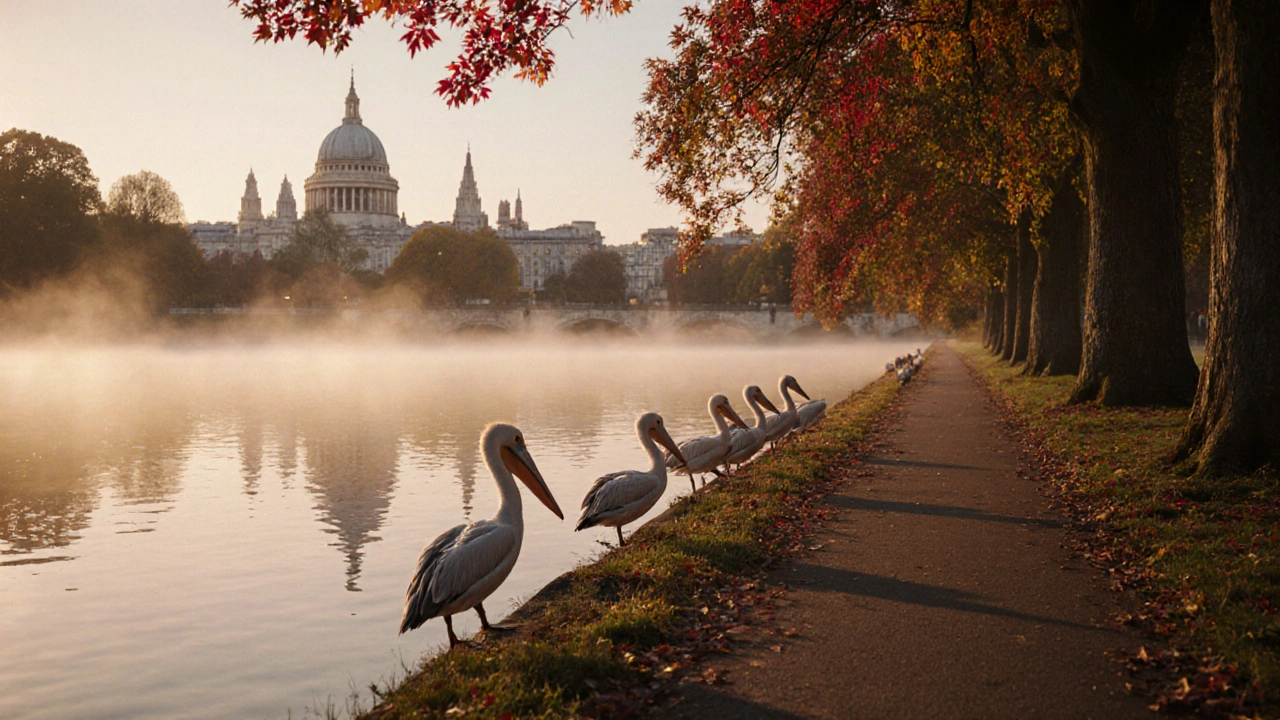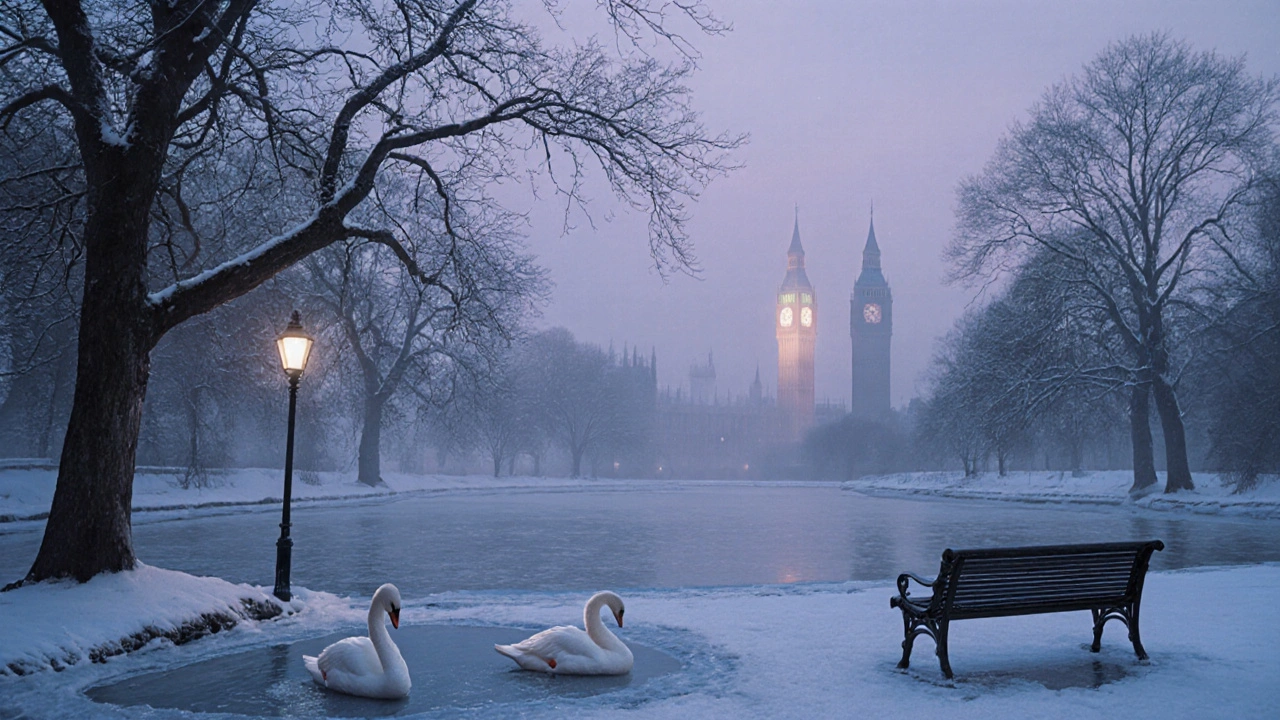
St James’s Park isn’t just another green patch in London. It’s the oldest royal park in the city, a quiet escape tucked between Buckingham Palace and the Houses of Parliament. If you’ve ever walked past the shimmering lake with ducks gliding under the arches of Horse Guards Parade, you know why it feels different. This isn’t a place you visit by accident. People come here to breathe, to watch the pelicans, to sit on a bench and forget the city exists.
The Lake That Never Sleeps
The lake is the heart of St James’s Park. It’s not huge-just under 20 acres-but it’s alive. Every morning, the same six pelicans waddle to the edge, waiting for their 11 a.m. feeding. They’ve been doing it since the 1660s, when Charles II got the first pair as a gift from a Russian ambassador. Today, they’re the park’s unofficial mascots. Locals know them by name: Percy, Mabel, and the others. Tourists line up with bread, but the staff only give them special pellets. Too much bread ruins their health.
The water reflects the sky. On a clear day, you can see the white dome of St Paul’s in the distance. In autumn, the maples turn fiery red, and the ducks swirl like confetti. In winter, the lake freezes at the edges, and the swans curl up on the ice like sleeping statues. You’ll see people feeding them-always the right food, never chips or biscuits. The park staff put up signs: ‘No bread. No junk. Only grains.’
A Royal Past, Not Just a Pretty View
Before it was a park, this land was a marshy swamp used for hunting deer. Henry VIII turned it into a hunting ground in the 1530s. He built a palace here, which later became St James’s Palace. The park was closed to the public until 1660, when Charles II reopened it after the Restoration. He wasn’t just being generous-he wanted to show off his power. The park became a stage for royal processions, fireworks, and public celebrations.
Today, the palace still stands, and the Queen’s Guard marches past every day. But the park belongs to everyone now. You’ll see joggers, artists sketching the bridge, nannies pushing strollers, and retirees reading newspapers on benches. No one checks your ID. No one asks why you’re here. That’s the magic of it.
Where the City Meets the Wild
St James’s Park is one of the few places in central London where nature feels wilder than the buildings around it. The trees here are old-some over 200 years. The oaks and beeches were planted by royal gardeners who knew exactly how to frame the view. Look east from the lake, and you’ll see the green dome of the Foreign Office. Look west, and the tower of Big Ben rises above the trees. The park doesn’t fight the city-it holds it gently.
There are no rollercoasters, no playgrounds, no ice cream vans. That’s intentional. The designers wanted calm, not chaos. You won’t find loud music or street performers. Just birdsong, the rustle of leaves, and the occasional splash of a duck diving for food.

Seasons That Change the Mood
Spring brings tulips. Thousands of them, planted in perfect rows by the park’s horticultural team. The colors shift every week-bright reds, deep purples, soft pinks. In May, the cherry blossoms bloom along the path near the bridge, and people sit under them with coffee in paper cups.
Summer is quiet. The heat bounces off the water, and the pelicans stretch their wings in the sun. You’ll see families with picnic baskets, but no one ever leaves trash. The park has a strict no-litter policy, and the staff enforce it with quiet authority. If you drop a wrapper, someone will hand it back to you before you even notice.
Autumn turns the park into a gold and copper mosaic. The leaves fall in thick layers, and the sound underfoot is soft, like walking on velvet. The swans start preparing for winter, tucking their heads under their wings. You’ll see volunteers checking the water quality, testing for pollution, making sure the fish survive.
Winter is the most peaceful. The lake is still. The pelicans huddle together. The trees are bare, and the sky feels closer. On foggy mornings, the park looks like a painting-muted, quiet, timeless. It’s the best time to walk here alone.
Why It Still Matters
In a city of 9 million people, St James’s Park is a place where time slows down. It’s not a tourist attraction you check off a list. It’s a living space, shaped by centuries of care. The park is managed by The Royal Parks charity, not the city council. That means it’s protected, funded, and preserved with a level of attention most urban parks don’t get.
It’s also a refuge for wildlife. Over 180 species of birds pass through here each year. Redwings in winter. Kingfishers in spring. Even the occasional heron, standing motionless in the shallows. The park’s ponds are designed to support frogs, dragonflies, and water beetles. It’s a tiny ecosystem in the middle of a metropolis.
And yet, no one talks about it like a nature reserve. It’s just… there. A quiet gift.

How to Visit Like a Local
You don’t need tickets. You don’t need a tour guide. Just show up.
- Go early. The best light for photos is before 9 a.m., when the park is empty and the mist rises off the lake.
- Bring a book. There are benches under the trees near the bridge-perfect for reading.
- Watch the pelicans at 11 a.m. They’re predictable, and it’s the only show in town.
- Walk the perimeter. The path loops around the lake in under 20 minutes. Do it twice, slowly.
- Don’t feed the ducks bread. Seriously. It kills them.
- Bring warm clothes. Even in summer, the wind off the water is sharp.
The nearest tube stops are St James’s Park (District and Circle lines) and Westminster (Jubilee, District, Circle). But if you’re coming from the south, walk across Westminster Bridge. The view of the park from the bridge-green, quiet, glowing-is the best way to arrive.
What You Won’t See on Instagram
Most photos of St James’s Park show the pelicans, the lake, the palace. But the real magic is in the details. The old man who brings his dog every day and sits on the same bench. The woman who paints the swans in watercolor every Tuesday. The student who reads poetry aloud to no one. The security guard who smiles when you say hello.
This park doesn’t need to be famous. It doesn’t need viral posts or hashtags. It’s been here longer than most of the buildings around it. It will outlast them too.
Can you swim in St James’s Park lake?
No, swimming is not allowed in St James’s Park lake. The water is monitored for wildlife and public safety, and it’s not treated for human contact. The park’s purpose is to provide a natural space for birds and visitors to enjoy peacefully-not for swimming or water sports.
Are dogs allowed in St James’s Park?
Yes, dogs are allowed but must be kept on a lead in most areas, especially near the lake and pelican feeding zones. There are designated off-leash areas near the north end of the park, but always check the signs. Owners are expected to clean up after their pets-bin bags are provided at key points.
Is St James’s Park free to enter?
Yes, St James’s Park is completely free to enter and explore. There are no tickets, no entry fees, and no opening hours. It’s open daily from dawn until dusk, and you can walk through at any time. The park is maintained by The Royal Parks charity, funded by donations and government support.
When is the best time to see the pelicans?
The pelicans are fed daily at 11 a.m., and that’s the best time to see them up close. They gather near the lake’s western edge, just past the bridge. Arrive by 10:45 to get a good spot. The feeding lasts about 15 minutes. Don’t try to feed them yourself-the staff use special pellets to keep them healthy.
Can you have a picnic in St James’s Park?
Yes, picnics are welcome. Bring a blanket and sit on the grass near the trees or along the lake’s edge. But don’t leave food waste behind. The park has strict no-litter rules, and bins are placed every 50 meters. Avoid plastic containers-use reusable ones. The park staff appreciate it.
What Comes Next
If you’ve walked St James’s Park and felt something shift-like the city slowed down for you-then you’ve felt its true purpose. It’s not just a park. It’s a pause button. A place where history, nature, and quiet dignity still live side by side.
Next time you’re in London, skip the crowded attractions. Walk here. Sit by the water. Watch the swans. Let the pelicans remind you that some things haven’t changed in 350 years. And that’s worth more than any photo.